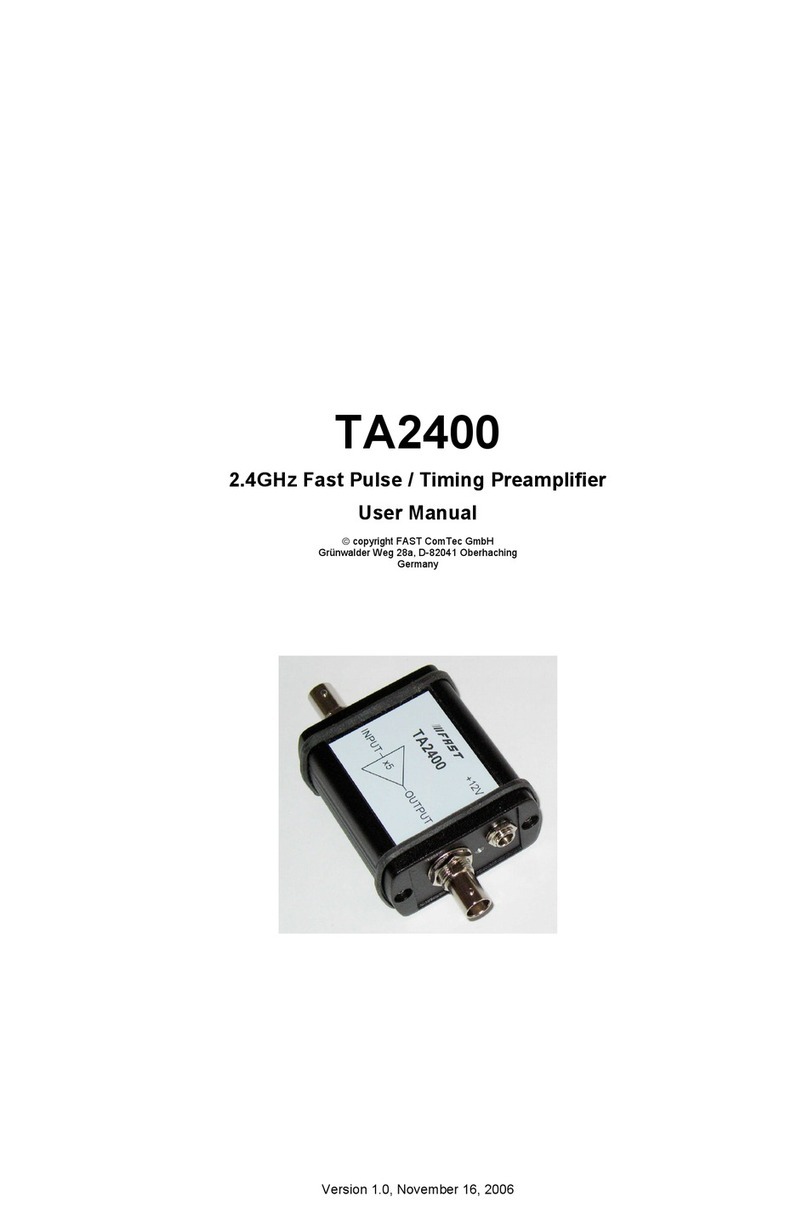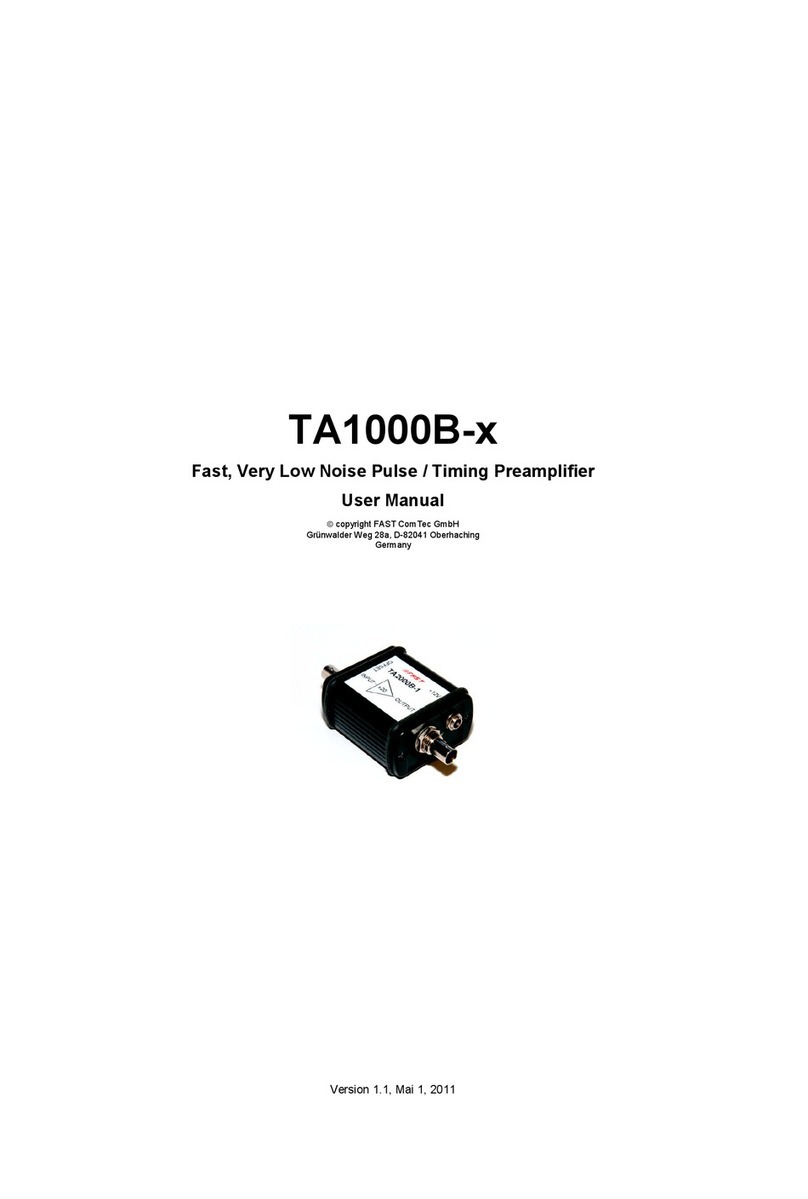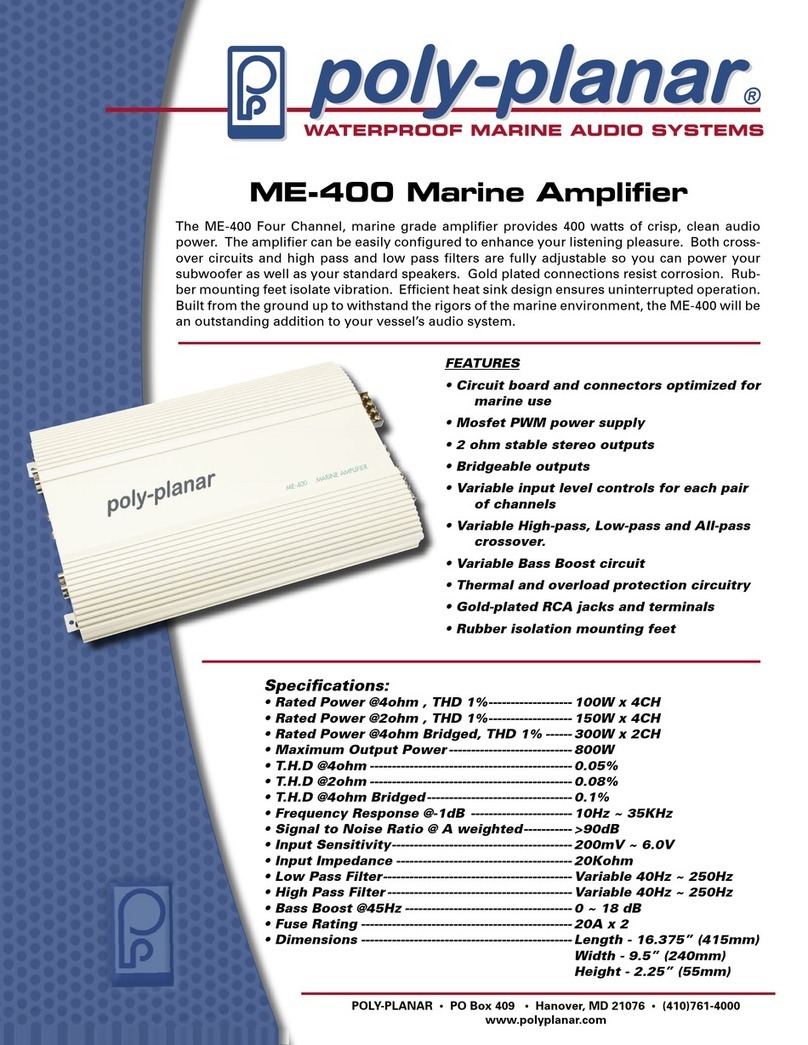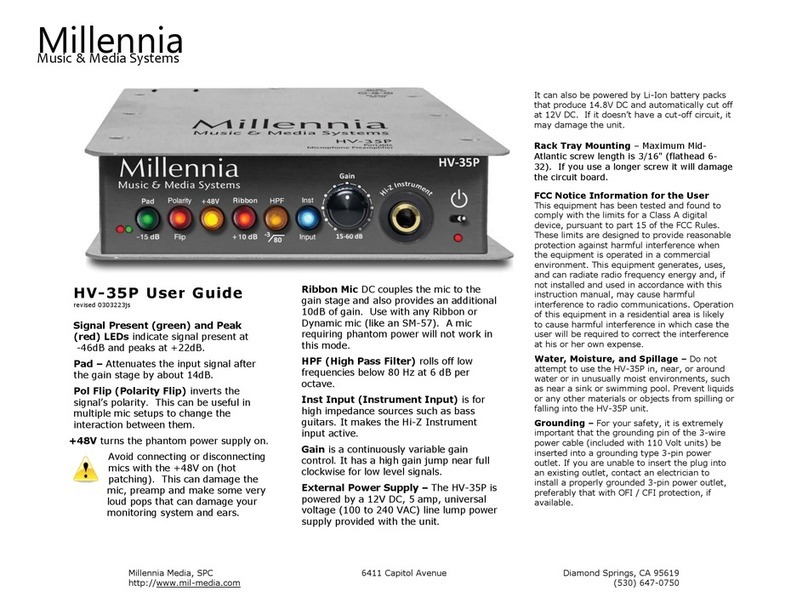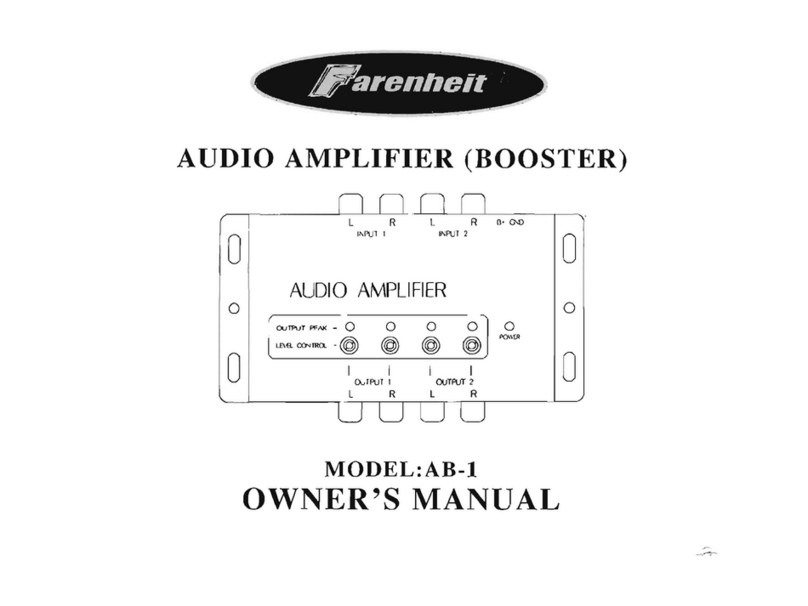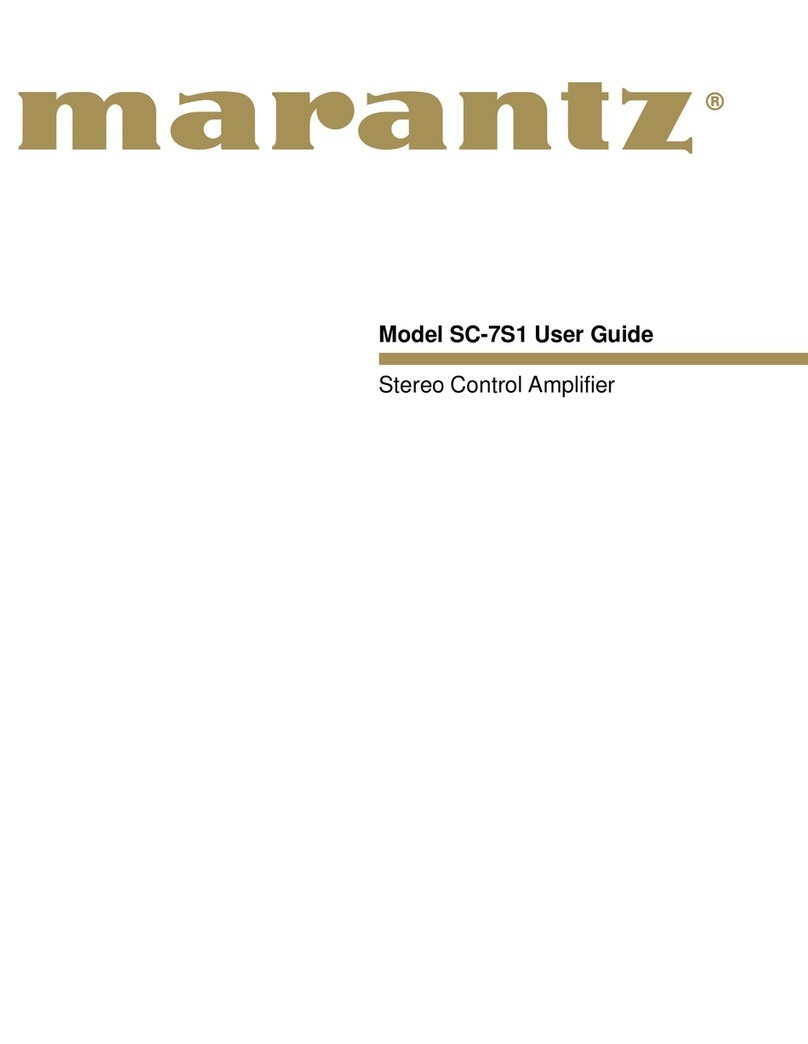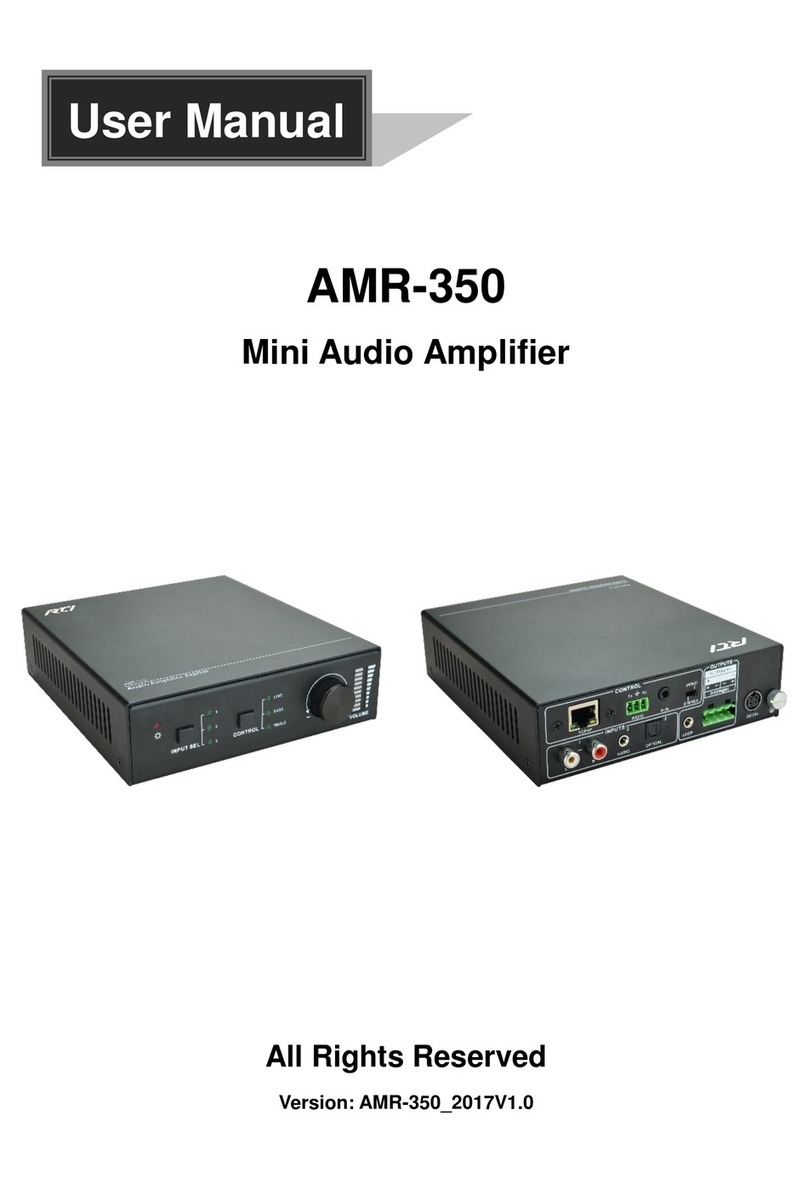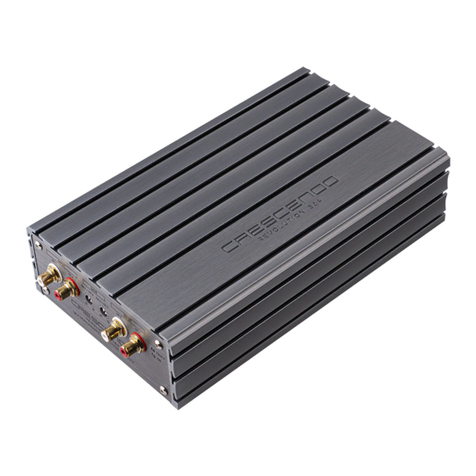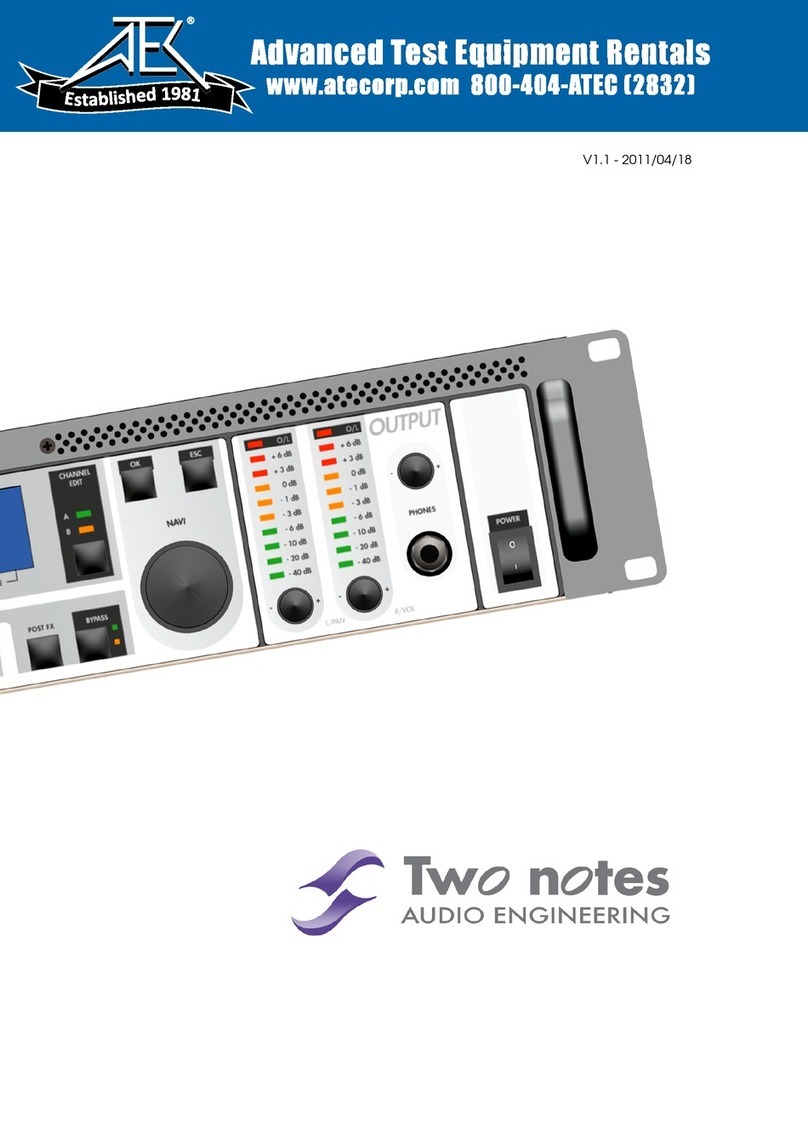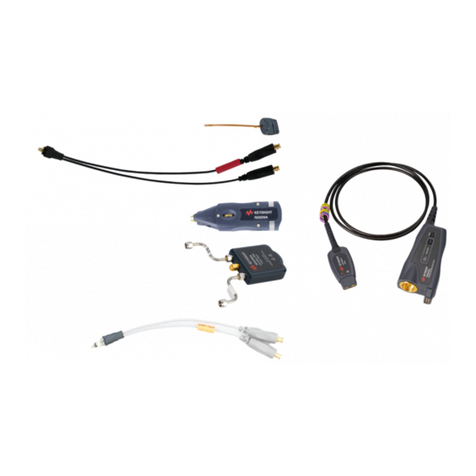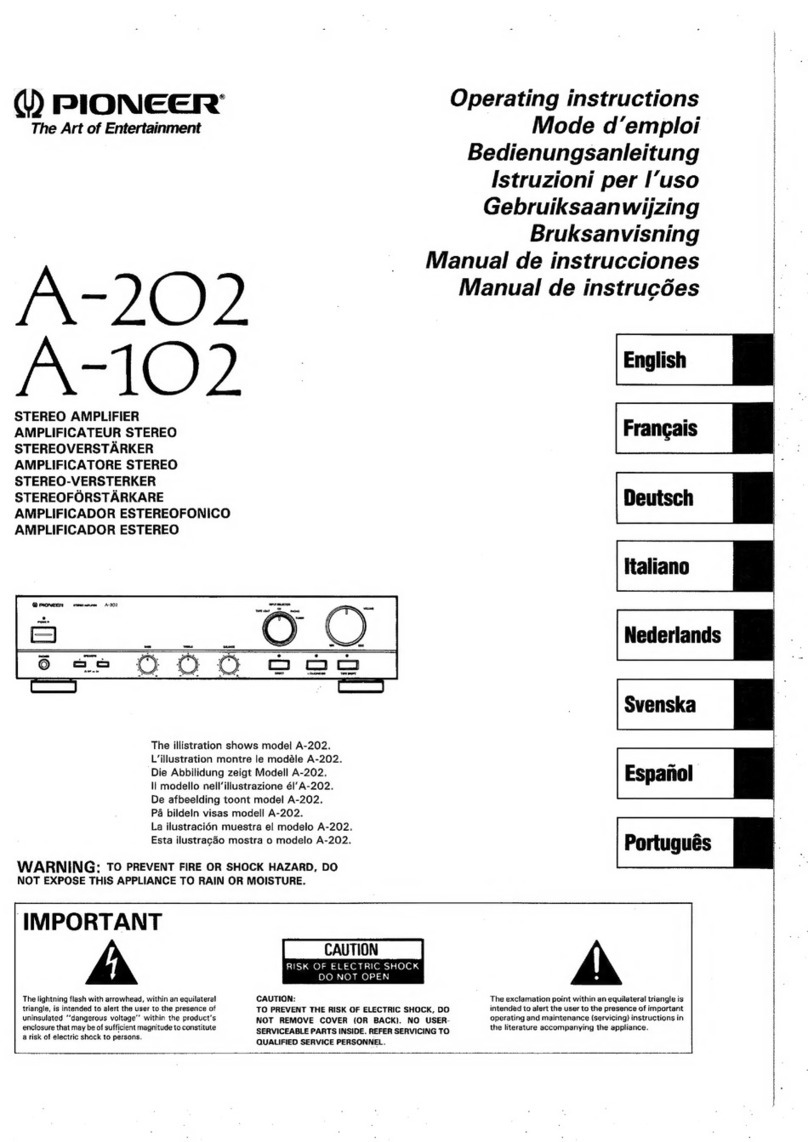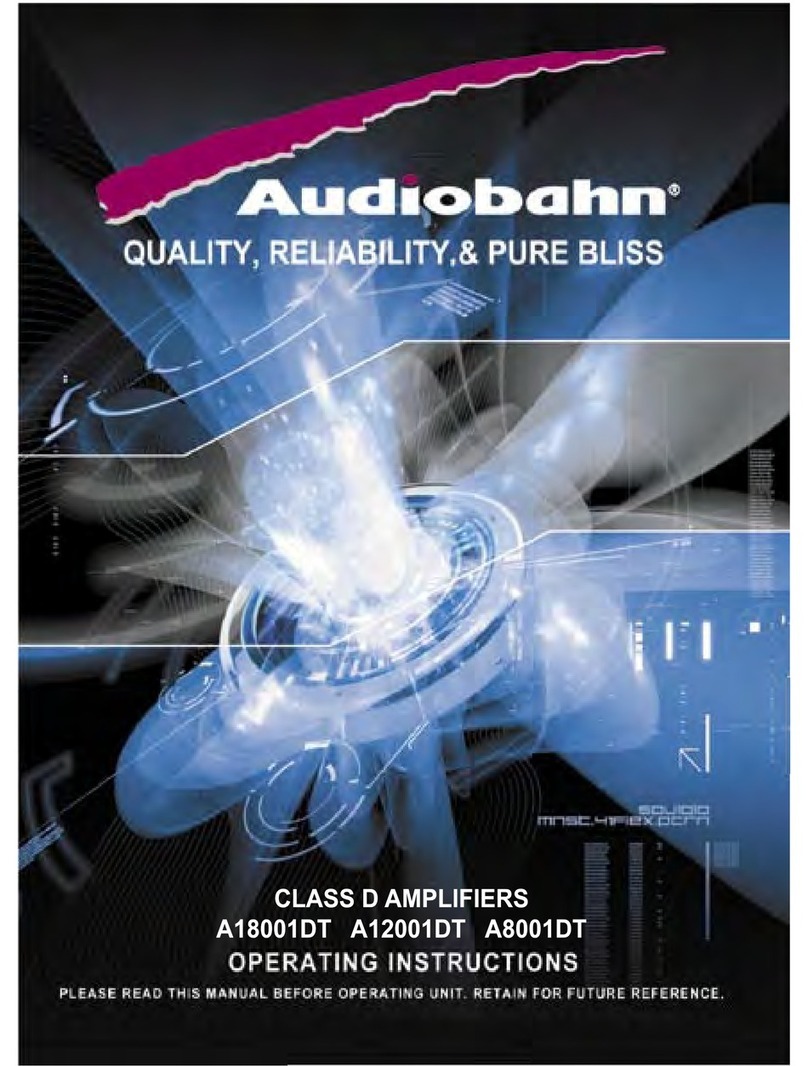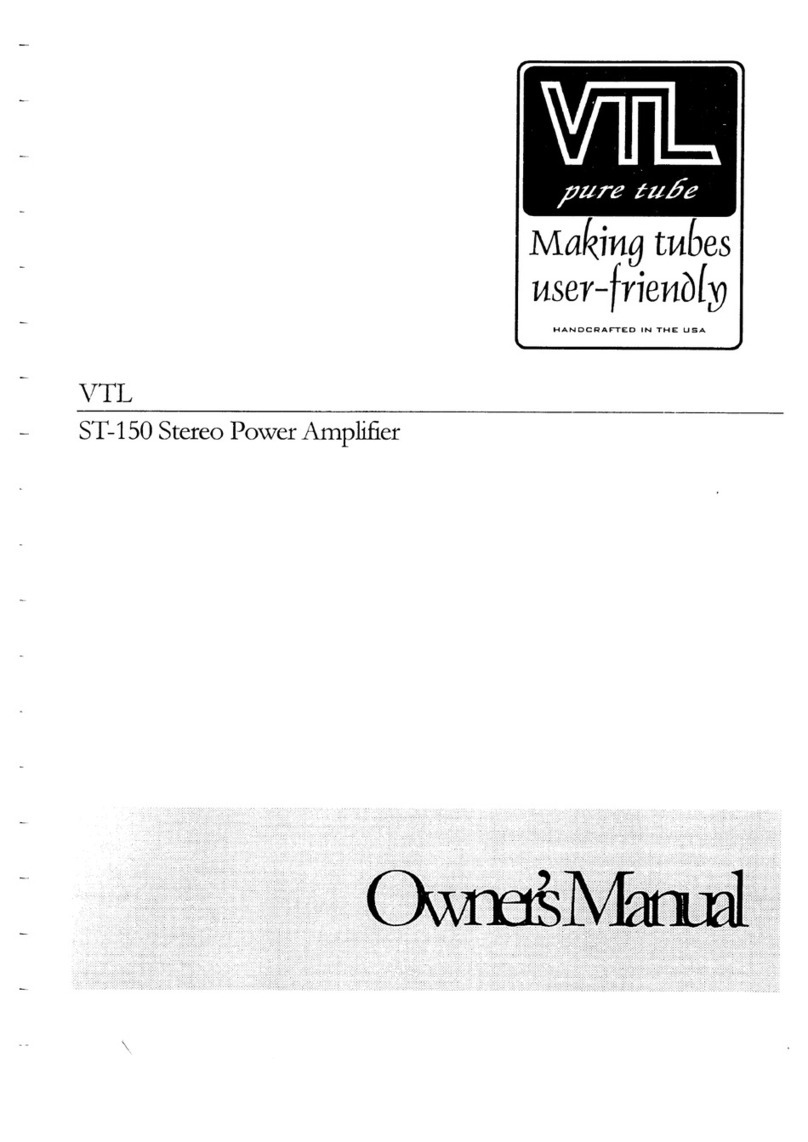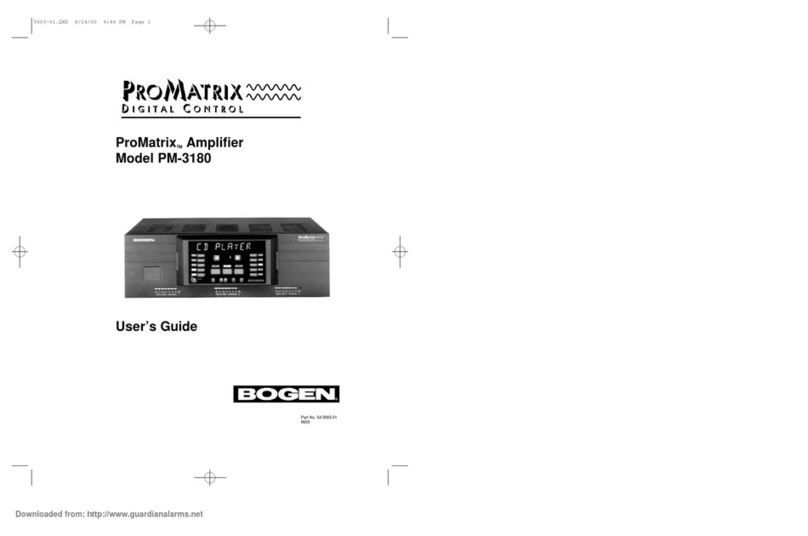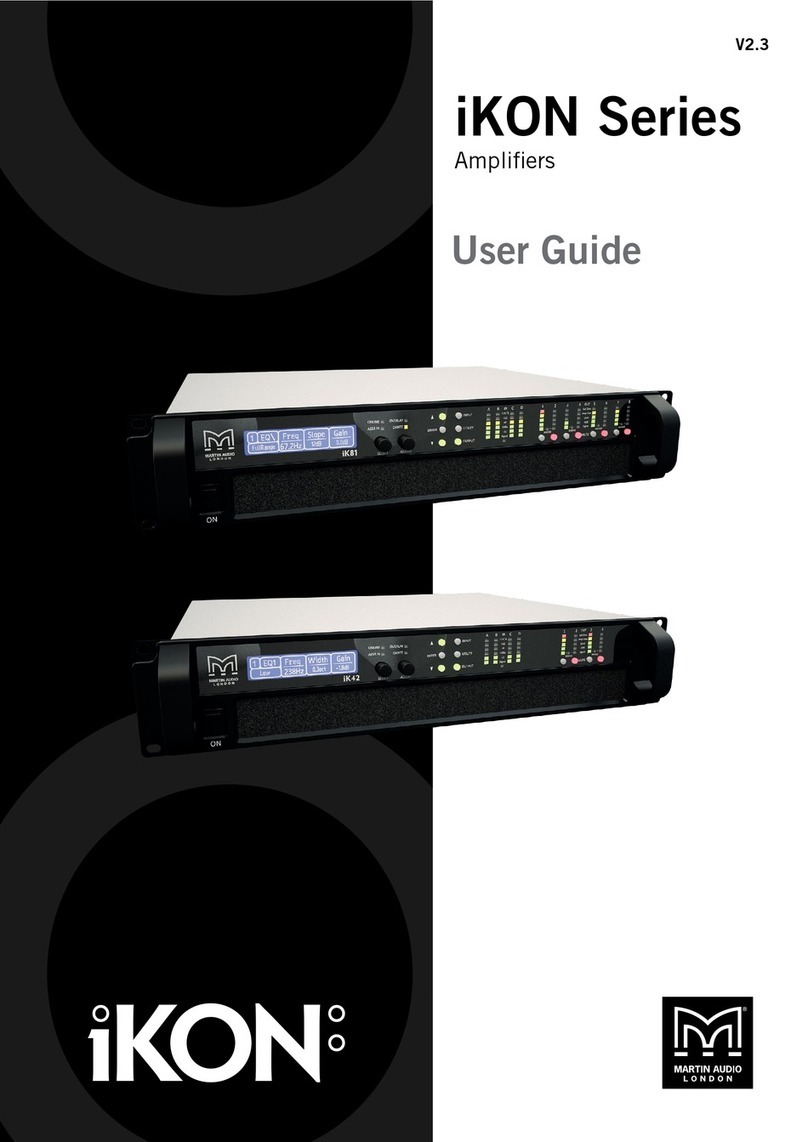FAST ComTec CSPA10 User manual

CSPA10 … 13
Charge Sensitive Preamplifier
User Manual
© Copyright FAST ComTec GmbH
Grünwalder Weg 28a, -82041 Oberhaching
Germany
Version 1.05, July 15, 2021
F ComTec Gmb 1

Warranty
Equipment manufactured by FAST ComTec GmbH is warranteed against defects in materials and
workmanship for a period of twelve months from date of shipment, provided that the equipment has been
used in a proper manner as detailed in the instructions manuals. uring the warranty period, repairs or
replacement will be made at FAST ComTec’s option on a return to factory basis. The transportation cost,
including insurance to FAST ComTec is the responsibility of the Costumer except for defects discovered
within 30 days after receipt of equipment where shipping expense will be paid by FAST ComTec.
Copyright Information
Copyright 2021 FAST ComTec Gmb ,
D-82041 Oberhaching, Germany. All rights reserved.
This manual contains proprietary information; no part of it may be reproduced by any means without prior
written permission of FAST ComTec, Grünwalder Weg 28a, -82041 Oberhaching, Germany.
Tel: +49 89 665180-0, FAX: +49 89 66518040
mail: [email protected]
The information in this manual describes the hardware and the software as accurately as possible, but is
subject to change without notice.
2F ComTec Gmb

CSPA1X_20210623 Page 1FAST ComTec GmbH, Grünwalder Weg 2 a, 2041 Oberhaching, phone: 49-(0) 9 6651 0 -0, fax: 49-(0) 9 6651 0 40, http://www.fastcomtec.com
Description
FAST ComTec’s CSPA10...13 is a single channel charge
sensitive preamplifier module intended for use with various
types of radiation detectors including semiconductor
detectors (e.g. CdTe and CZT), p-i-n photodiodes,
avalanche photodiodes (APDs), and various gas-based
detectors.
The CSPA10 is one of a series of four charge sensitive
preamplifiers offered by FAST ComTec, which differ from
each other most notably by their gain. A guide to selecting
the best charge sensitive preamplifier for your application
can be found at our web site: http://www.fastcomtec.com.
The CSPA1X is a successor model of CSP1X, with easier
classic power supply. Other improvements include
integrated protection circuits and better variability.
Equivalent circuit diagram
Figure 2 shows a simplified equivalent circuit diagram of the
CSPA10, which is a two stage amplifier. The first stage is
high gain, and the second stage is low gain with an
emphasis on supplying sufficient output current to drive a
terminated coaxial cable. Rf (100 MΩ) and Cf (1.4 pF) are
the feedback resistor and capacitor respectively (tdecay=
140μs). The feedback values for the other models are:
Rf =10 MΩ and Cf =15 pF, tdecay= 150μs (CSPA11),
Rf =6 0 kΩ and Cf =75 pF, tdecay= 50μs (CSPA12),
Rf =6 kΩ and Cf =750 pF, tdecay= 50μs (CSPA13).
Theory of operation
Charge sensitive preamplifiers are used when radiation is
detected as a series of pulses, resulting in brief bursts of
current flowing into or out of the preamplifier input.
Depending on the type of detector, this burst of current may
be very brief (<1 ns) or as long as a few μs. For an
idealized detection current pulse taking the form of a delta
function, the detected charge (time integral of the input
current) will ideally take the form of a step function.
The output waveform of an actual charge sensitive
preamplifier will of course have a non-zero rise time: for the
CSPA10 this figure is approximately 7 ns. Furthermore,
capacitance at the preamplifier input (i.e. detector
capacitance) will further slow the rise time at a rate of
0.4 ns / pF. Keep in mind the output rise time will also be
limited by the speed of the detector. For example, the
detection current pulse from a CsI(Tl)/photodiode
scintillation detector has a duration of approximately a
couple μs, so the expected rise time of the charge sensitive
preamplifier output will be at least that long.
The output waveform of the CSP10 using a capacitively
coupled fast square wave pulser at the input is shown below
to the left. At long time domains, the output decays due to
the discharge of the feedback capacitor through the
feedback resistor, with an RC time constant of 140 μs. This
decay of the output waveform is also shown below, to the
right.
CSPA1X charge sensitive preamplifier

CSPA1X_20210623 Page 2FAST ComTec GmbH, Grünwalder Weg 2 a, 2041 Oberhaching, phone: 49-(0) 9 6651 0 -0, fax: 49-(0) 9 6651 0 40, http://www.fastcomtec.com
CSPA1X charge sensitive preamplifier
Specification
Preamplification channels: 1
Equivalent noise charge (ENC)*:
ENC MS: 200 electrons, 0.03 femtoCoul.
Equivalent noise in silicon: 1.7 keV (FWHM)
Equivalent noise in CdZnTe: 2.4 keV (FWHM)
ENC slope: 4 electrons RMS pF
Gain: see table 1
ise time**: 7 ns (see table 1)
Decay time constant: 140 μs (150 μs, 50 μs, 50 μs resp.)
Unsaturated output swing: -3 to +3 volts
Maximum charge detectable per event: (see table 1)
Power supply voltage (Vs): +12 volts nominal
Power supply current: < 30 mA
Power dissipation: < 400 mW
Operating temperature: -40 to +85°C
Output offset: +0.2 to -0.2 volts
Output impedance: 1 or 50 ohms, set by jumper
Physical: Net weight: 195 g (320 g including power supply)
Size without connectors: 113 mm x 70 mm x 24 mm
Size with connectors: 153 mm x 70 mm x 24 mm
* Measured with input unconnected, using Gaussian
shaping amplifier with time constant =1 μs. With a detector
attached to the input, noise from the detector capacitance,
leakage current, and dielectric losses will add to this figure.
** Pulse rise time (defined as the time to attain 90% of maximum
value) has a linear relationship with input capacitance.
Value cited in the table assumes zero added input capacitance.
Tocalculate pulse rise time for practical situations,
use the equation: tr =0.4 Cd + 7 ns, where tr is the pulse rise
time in ns, and Cd is the added capacitance (e.g. detector
capacitance) in pF.
Keep in mind that others factors within the detection system
may further limit this value.
Table 1: Sensitivity Versions
Preamp model Gain (mV
/picoCoulomb)
Max. detect.
Pulse (e-)
equiv. noise in
silicon keV
( WHM)
CSPA10 1400 107 1.7 keV
CSPA11 150 108 6.0 keV
CSPA12 15 109 65 keV
CSPA13 1.5 1010 230 keV
Table 2: model specifications (noise, risetime)
Preamp model noise (ENC)
e- (RMS)*
noise (ENC)
slope e- /p
rise time
(Cd=0p )
rise time slope
CSPA10 200 e- 4 e- /p 7 ns 0.4 ns/p
CSPA11 630 e- 3.7 e- /p 3 ns 0.25 ns/p
CSPA12 6,800 e- 28 e- /p 6 ns 0.25 ns/p
CSPA13 24,000 e- 27 e- /p 20 ns 0.25 ns/p
Table 3: input / High voltage connectors
model Input Connectors input / HV
CSPA1X-2S 2 kV / 10 n SHV / SHV
CSPA1X-4S 4 kV / 4.7 n SHV / SHV
CSPA1X-1B 1 kV / 10 n BNC / BNC
CSPA1X-1BS 1 kV / 10 n BNC / SHV
Table 4: ordering information
Model No. Description Order No.
CSPA10-2S Charge-sensitive preamp, SHV, 2kV/10n , 1.4 V/pC CSPA102S
CSPA11-2S Charge-sensitive preamp, SHV, 2 kV/10 n , 150 mV/pC CSPA112S
CSPA12-2S Charge-sensitive preamp, SHV, 2kV/10n , 15 mV/pC CSPA122S
CSPA13-2S Charge-sensitive preamp, SHV, 2 kV/10 n , 1.5 mV/pC CSPA132S
CSPA10-4S Charge-sensitive preamp, SHV, 4kV/4.7n , 1.4 V/pC CSPA104S
CSPA11-4S Charge-sensitive preamp, SHV, 4 kV/10 n , 150 mV/pC CSPA114S
CSPA12-4S Charge-sensitive preamp, SHV, 4kV/4.7n , 15 mV/pC CSPA124S
CSPA13-4S Charge-sensitive preamp, SHV, 4 kV/10 n , 1.5 mV/pC CSPA134S
CSPA10-1B Charge-sensitive preamp, BNC, 1 kV/10 n , 1.4 V/pC CSPA101B
CSPA11-1B Charge-sensitive preamp, BNC, 1 kV/10 n , 150 mV/pC CSPA111B
CSPA12-1B Charge-sensitive preamp, BNC, 1 kV/10 n , 15 mV/pC CSPA121B
CSPA13-1B Charge-sensitive preamp, BNC, 1 kV/10 n , 1.5 mV/pC CSPA131B
CSPA10-1BS Charge-sensitive preamp, BNC/SHV, 1kV/10n ,1.4 V/pC CSPA101BS
CSPA11-1BS Charge-sensitive preamp, BNC/SHV,1kV/10n ,150mV/pC CSPA111BS
CSPA12-1BS Charge-sensitive preamp, BNC/SHV, 1 kV/10n ,15mV/pC CSPA121BS
CSPA13-1BS Charge-sensitive preamp, BNC/SHV, 1kV/10n ,1.5mV/pC CSPA131BS
Front view:
Input Test in
Back view:
Power Supply Output HV input

Table of Contents
1 Introduction............................................................................................................................................... 6
2 Specifications............................................................................................................................................ 8
2.1 Inputs................................................................................................................................................ 8
2.2 Outputs............................................................................................................................................. 8
2.3 Performance..................................................................................................................................... 8
2.4 Connector types and cables............................................................................................................. 9
2.5 Power............................................................................................................................................... 9
2.6 Physicals.......................................................................................................................................... 9
3 Controls and Connectors........................................................................................................................ 10
3.1 General........................................................................................................................................... 10
3.2 Front Panel / Rear Panel................................................................................................................ 10
4 Installation............................................................................................................................................... 11
4.1 Noise Consideration........................................................................................................................ 11
4.2 etector Bias.................................................................................................................................. 11
5 Operating Instructions............................................................................................................................. 12
5.1 General........................................................................................................................................... 12
5.2 Test Input........................................................................................................................................ 12
5.3 Initial Setup..................................................................................................................................... 12
5.4 Initial Checkout............................................................................................................................... 12
5.5 Protection Circuit............................................................................................................................ 13
5.6 Common Operating Problems........................................................................................................ 13
6 Theory of Operation................................................................................................................................ 15
6.1 Functional escription.................................................................................................................... 15
6.2 etailed Circuit escription............................................................................................................. 15
7 Jumper setting & opening of the case................................................................................................. 17
8 Appendix................................................................................................................................................. 18
8.1 etailed Schematic of the CSPA10…13.........................................................................................18
8.2 Personal Notes............................................................................................................................... 19
F ComTec Gmb 3

Table of Figures
Fig. 1.1: Functional Schematic diagram....................................................................................................... 7
Fig. 3.1: Front- and Rear panel.................................................................................................................. 10
Fig. 6.1: Simplified circuit diagram............................................................................................................. 16
Fig. 7.1: CSPA1X board with jumpers........................................................................................................ 17
Fig. 7.2: CSPA1X board with connectors................................................................................................... 17
Fig. 8.1: etailed circuit diagram of CSPA1X.............................................................................................18
4F ComTec Gmb

WARNINGS
The input of the CSPA1X is very sensitive. Never connect the detector when the high voltage is
applied. Increase or decrease the high voltage only at a very slow rate. Observe the output of
the CSPA1X during bias voltage change with an oscilloscope. Do not allow the output to
saturate during change of high voltage.
F ComTec Gmb 5

Introduction
1 Introduction
FAST ComTec’s CSPA10...13 is a single channel charge sensitive preamplifier module intended for use
with various types of radiation detectors including semiconductor detectors (e.g. Si, CdTe and CZT), P-I-N
photodiodes, avalanche photodiodes (AP s), and various gas-based detectors. The CSPA10...13 is one
of a series of four charge sensitive preamplifiers offered by FAST ComTec, which differ from each other
most notably by their gain. A guide to selecting the best charge sensitive preamplifier for your application
can be found on the next page or at our web site: http://www.fastcomtec.com. As with all FAST ComTec’s
preamplifier modules, the CSPA10...13 is housed in a small shielded metal case with a input for plug-in
power supply.
CSPA1x is a successor model of CSP1x, which includes easier supply with classic plug-in power supply.
Other improvements include integrated protection circuit and better variability.
The FAST ComTec Model CSPA10...13 Charge Sensitive Preamplifier is designed for optimum
performance with Silicon Surface Barrier (SSB) detectors. Operating as a charge to voltage converter, the
unit accepts charge carriers produced in the detector during each absorbed nuclear event. The output
then provides a voltage in direct proportion to the collected charge at the rate of 1.4V per picocoulomb.
This translates to a gain of 62mV per MeV (see table) for room temperature silicon detectors.
For typical use with positively biased SSB detectors, the extremely linear energy output provides a
negative polarity pulse ideal for energy spectroscopy.
The high charge rate capability of the design is evidenced by an energy rate capacity of greater than 10 5
MeV per second when used with silicon detectors. In order to take full advantage of such a high count
rate capabilty, a main amplifier with a correspondingly high count rate ability, such as the FAST ComTec
Model CSA4, should be used.
The basic operation of the preamplifier is indicated in the functional schematic diagram below, see Fig.
1.1. The first stage acts as an operational integrator which produces an output potential proportional to
the accumulated charge on the feedback capacitor Cf. The integrator drives the output buffer with a gain
of +2.
The noise contribution of the preamplifier is only 1.7 KeV, FWHM, (Si) with an increase of less than 34 eV
for each picofarad of additional source capacitance. To reduce noise injected through the HV input, a
decoupling network is utilized for filtering the detector bias voltage.
To reduce the possibility of transmission line reflections when using long lengths of coaxial cable, the
energy output is provided with a series resistor, eliminating the necessity of terminating the line at the
receiving end.
For those applications utilizing lower voltage detectors with vacuum chamber feedthrough connectors or
direct detector cabling inside a chamber, the Model CSPA10...13-1B provides a BNC for the detector and
HV bias input. Necessary power is provided by any FAST ComTec main amplifier through the five foot
compatible cable furnished with the preamp.
6F ComTec Gmb

Introduction
Tables to the CSP10...13
F ComTec Gmb 7
Fig. 1.1: Functional Schematic diagram
Table 1: Sensitivity Versions
Preamp
model
Gain (mV
/picoCoulomb)
Max. detect.
Pulse (e-)
equiv. noise in
silicon keV (FWHM)
CSPA10 1400 107 1.7 keV
CSPA11 150 108 6.0 keV
CSPA12 15 109 65 keV
CSPA13 1.5 1010 230 keV
Table 2: model specifications (noise, risetime)
Preamp
model
noise (ENC)
e- (RMS)*
noise (ENC)
slope e- /pF
rise time
(Cd=0pF)
CSPA10 200 e- 4 e- /pF 7 ns
CSPA11 630 e- 3.7 e- /pF 3 ns
CSPA12 6,800 e- 28 e- /pF 6 ns
CSPA13 24,000 e- 27 e- /pF 20 ns
Table 3: input / Hi h volta e connectors
model Input Connectors input / HV
CSPA1X-2S 2 kV / 10 nF SHV / SHV
CSPA1X-4S 4 kV / 4.7 nF SHV / SHV
CSPA1X-1B 1 kV / 10 nF BNC / BNC
CSPA1X-1BS 1 kV / 10 nF BNC / SHV
Table 4: orderin information
Model No. escription Order No.
CSPA10-2S Charge-sensitive preamp, SHV, 2kV/10nF, 1.4 V/pC CSPA102S
CSPA11-2S Charge-sensitive preamp, SHV, 2 kV/10 nF, 150 mV/pC CSPA112S
CSPA12-2S Charge-sensitive preamp, SHV, 2kV/10nF, 15 mV/pC CSPA122S
CSPA13-2S Charge-sensitive preamp, SHV, 2 kV/10 nF, 1.5 mV/pC CSPA132S
CSPA10-4S Charge-sensitive preamp, SHV, 4kV/4.7nF, 1.4 V/pC CSPA104S
CSPA11-4S Charge-sensitive preamp, SHV, 4 kV/10 nF, 150 mV/pC CSPA114S
CSPA12-4S Charge-sensitive preamp, SHV, 4kV/4.7nF, 15 mV/pC CSPA124S
CSPA13-4S Charge-sensitive preamp, SHV, 4 kV/10 nF, 1.5 mV/pC CSPA134S
CSPA10-1B Charge-sensitive preamp, BNC, 1 kV/10 nF, 1.4 V/pC CSPA101B
CSPA11-1B Charge-sensitive preamp, BNC, 1 kV/10 nF, 150 mV/pC CSPA111B
CSPA12-1B Charge-sensitive preamp, BNC, 1 kV/10 nF, 15 mV/pC CSPA121B
CSPA13-1B Charge-sensitive preamp, BNC, 1 kV/10 nF, 1.5 mV/pC CSPA131B
CSPA10-1BS Charge-sensitive preamp, BNC/SHV, 1kV/10nF,1.4 V/pC CSPA101BS
CSPA11-1BS Charge-sensitive preamp, BNC/SHV,1kV/10nF,150mV/pC CSPA111BS
CSPA12-1BS Charge-sensitive preamp, BNC/SHV, 1 kV/10nF,15mV/pC CSPA121BS
CSPA13-1BS Charge-sensitive preamp, BNC/SHV, 1kV/10nF,1.5mV/pC CSPA131BS

Specifications
2 Specifications
2.1 Inputs
Preamplification channels: 1
up to ± 4000 volts (SHV connector)
± 4000 volts (SHV connector)
Test input 50 ohms terminated fort tail pulser
2.2 Outputs
ecay time constant: 140 µs (150 µs, 50 µs, 50 µs resp.)
Unsaturated output swing: -3 to +3 volts
Output offset: +0.2 to -0.2 volts
Output impedance: 50 ohms
2.3 Performance
Equivalent noise charge (ENC)*: ( see table 1, CSPA10)
ENC RMS: 200 electrons, 0.03 femtoCoul. (CSPA10)
Equivalent noise in silicon: 1.7 keV (FWHM)
Equivalent noise in CdZnTe: 2.4 keV (FWHM)
ENC slope: 4 electrons RMS /pF
Gain: see table 1
Rise time**: 7 ns ( see table 2 page 2, CSPA10 )
Maximum charge detectable per event: (see table 1)
Operating temperature: -40 to +85ºC
• Measured with input unconnected, using Gaussian shaping amplifier with time constant =1 s. With a detector attached to the
input, noise from the detector capacitance, leakage current, and dielectric losses will add to this figure.
** Pulse rise time (defined as the time to attain 90% of maximum value) has a linear relationship with input capacitance. Value cited
in the table assumes zero added input capacitance. o calculate pulse rise time for practical situations, use the equation: tr =0.4 Cd
+ 7 ns, where tr is the pulse rise time in ns, and Cd is the added capacitance (e.g. detector capacitance) in pF.
Keep in mind that other factors within the detection system may further limit this value.
8F ComTec Gmb

Specifications
2.4 Connector types and cables
Power: power connector 2.1 x 5.5 mm, C connector, center positive;
HV Input: SHV (BNC for CSPA1X-1B)
etector Input: SHV for the models CSPA1x-2S, CSPA1x-4S
BNC for the models CSPA1x-1B
Output: BNC
Test input: BNC
2.5 Power
Power supply voltage (Vs): + 12 volts nominal ( ext. 12V plug-in power supply with 1,8m cable )
Power supply current: < 30 mA
Power dissipation: < 400 mW
2.6 Physicals
Net weight case : 195 gr ( Net weight: approx. 320 gr with plug-in power supply )
Size without connectors: 113 mm x 70 mm x 24 mm
Size with connectors: 153 mm x 70 mm x 24 mm
F ComTec Gmb 9

Controls and Connectors
3 Controls and Connectors
3.1 General
This section describes the functions of the controls and connectors located on the front and rear panels of
the Model CSPA10...13. It is recommended that this section be read before proceeding with the operation
of the preamplifier.
3.2 Front Panel / Rear Panel
10 F ComTec Gmb
Input Test input Power Supply Output HV input
l
Fig. 3.1: Front- and Rear panel

Installation
4 Installation
4.1 Noise Consideration
The preamplifier components associated with the detector bias (HV) have been scientifically cleaned.
This process removes all residues and fingerprints which could cause excessive noise and possible
failure of the preamplifier when high voltage is applied. It is strongly recommended that causion be
exercised never to touch these components nor have them exposed to the atmosphere without the
preamplifier case, for any long duration.
Any capacitance added to the input of the preamplifier will increase the noise contribution and degrade
the rise time performance of the Model CSPA10…13. The capacitance should be minimized by using the
shortest possible interconnecting cable between the detector and the preamplifier.
The detector load resistance R is normally 100 megaohms. If silicon surface barrier detectors are used
whose leakage current is greater than 1 microamp, the voltage drop across the resistor must be allowed
for, or alternatively, the value of R reduced to provide a voltage drop. The latter will cause the 0 pF noise
of the preamplifier to increase, but this will usually be insignificant compared to the noise generated in the
detector by the increased leakage current. o not reduce R below 10 megaohms without contacting the
factory.
4.2 Detector Bias
The Model CSPA1X-4S Preamplifier HV Input accepts up to ± 4000 V C from the detector bias supply.
Never connect or disconnect the preamplifier from a detector while the high voltage is on.
Always wait at least one minute after the detector bias has been reduced to zero before disconnecting the
preamplifier from the detector. Maximum stability of the preamplifier is maintained 60-90 seconds after
preamplifier power and high voltage is applied.
The Model CSPA1X-2S has a larger input coupling capacitor (18 nF) for detectors with high capacity . If
the maximum detector bias is below 1000V, the Model CSP1AX-1B is the right choice.
The input connector and the HV bias connector is BNC. It is usually more convenient to use BNC,
because these connectors are much more common.
For Vacuum applications, the feed through connector is in many cases only available as BNC.
F ComTec Gmb 11

Operating Instructions
5 Operating Instructions
5.1 General
The purpose of this section is to familiarize the user with the Model CSPA10...13 Preamplifier and to
check that the unit is operating correctly. Since it is difficult to determine the exact system configuration in
which the unit will be used, explicit operating instructions cannot be given. However, if the following
procedure is carried out the user will gain sufficient familiarity with the instrument to permit its proper use
in the system at hand.
The instructions which follow may be best carried out with the preamplifier on latest bench, seperated
from the detector.
Because the input is charge sensitive, and ultra high impedances are involved, the Preamplifier is
inherently somewhat microphonic. For best results, testing should be done with the Preamplifier chassis
cushioned on a block of foam rubber, and the cover securely fastened to the frame.
5.2 Test Input
The Model CSPA10...13 accommodate a TEST input via a BNC connector on the front panel introduces
the externally applied signal (preferably a negative tail pulse of -1 to -5 volt peak amplitude) to a charge
injection capacitor to the summing junction of the inegrator. The test signal voltage is usually adjusted in
amplitude by the user so as to give a reference peak signal in his data spectrum at a convinient location
so as to normalize multiple detectors. This input does provide a resistive terminating impedance.
In the endless mode data acquisition is started only once, e.g. by a software start i.e. asynchronously to
the rest of the experiment. Then all arriving events are recorded and stored with an absolute time relative
only to the initial start. Since the dynamic range is up to 53 bit or 8.3 days the available absolute time
range will be sufficient for every imaginable experiment.
5.3 Initial Setup
1. Connect the Preamp to a source of low voltage power such as a FAST ComTec Spectroscopy
Amplifier using the five foot cable provided.
2. Using the RG-58C/U coax, connect the Preamp output to channel 1 of a dual trace
Oscilloscope.
3. Connect the negative, attenuated output of a tail pulse generator (such as the Berkeley
Nucleonics Corp.: BH-1, PB-5 Tail Pulser) to channel 2 using RG-58C/U and a „tee“ at the
Scope input.
4. The other side of the „tee“ should be connected to the Test input BNC connector through a
length of RG-58C/U coax.
5. Select Scope vertical sensitivities of 50 mV/div. And set the time base to 10 µs/div. Turn
Preamp power on.
5.4 Initial Checkout
Using the Test input BNC provided on the Model CSPA10...13, a detector input of approximately 100 MeV
per input volt is simulated. Adjust the pulse generator for -100 mV peak input signal and observe a
Preamplifier energy output of +150 mV peak (nominal). This is equivalent to a detector input of 2.4 MeV
(nominal).
For the CSPA11, you should get about +16 mV from a –100 mV test signal and for the CSPA12, you
should get about +16 mV from a –1000 mV test signal.
12 F ComTec Gmb

Operating Instructions
5.5 Protection Circuit
CSPA1x is designed among others to realize better usability and trouble-free power supply.
The detector input is protected by implemented diodes network circuit. It minimally increases the internal
capacitance and thus also the values of internal noise. You can disable this function as needed (Fig. 7.1
Jumper J2: to pos. 2-3 )
Further protection of measure is built-in input ser. resistor = 100 Ohm.This resistor is deactivated in order
to keep the noise at a low level (Fig. 7.1. JP3 pos. 1-2).
The output resistor is set to 1 Ohm by default via jumper JP9. Alternatively you can increase this value to
50 Ohm ( better output protection ). The disadvantage is the halved value of the effective output signal.
5.6 Common Operating Problems
The modern spectrometer is an extremely sensitive, state-of the-art system. Inexact performance of other
than the grossest type is generally due to subtle factors. It is the ability to determine and correct these
factors that constitutes the art in the science of spectroscopy instrumentation.
All of the many possible contributors to less than optimum performance cannot be listed here. The
purpose of this section is to note the usual causes of loss of resolution, and to suggest curative steps.
o not expect to diagnose all problems with the detector, a preamplifier, a main amplifier, and a
multichannel analyzer. The spectroscopy system records results, it does not necessarily lead to the
identification of causes. A good, modern oscilloscope will be needed. Also a high quality tail pulse
generator will be extremely useful.
The simplest test is, of course, to connect your detector, apply bias, present a source, and accumulate a
spectrum. Be sure a pulser is not feeding the preamplifier while the spectrum is accumulating, or
resolution loss may result. If the results obtained are far different from what is expected, it then becomes
necessary to troubleshoot the system.
First observe the amplifier output on an oscilloscope at various time base and amplitude settings. Is the
amplifier properly pole/zero cancelled (do the output pulses cause undershoot that persist for longer than
two or more main pulse widths)? Set the main amplifier pole/zero cancellation (without C resolution) to
obtain the most rapid, complete baseline recovery.
The next step is to remove all sources and, with the detector still connected and bias applied, present a
test pulse to the detector input of the preamplifier using the test input described in Section 5-2. Make sure
the pulser polarity is correct. Set the amplitude of the pulser so that its peak occurs near the region of the
peak of the source previously used.
Observe the output of the amplifier without C restoration. Note that the amplifier is not properly
pole/zero canceled for the pulser feeding the preamp (due to the extra time constant of the pulser). This is
of no consequence for a pure pulser input. Are the baseline fluctuations of 50/60 or 100/120 Hz
frequency? A ground loop is indicated. Insert all system line plugs into the same output. Or are the
baseline fluctuations of random frequency between 10 Hz and 15,000 Hz? The area may be too noisy,
causing microphonic problems.
If high frequency noise is observed, is it random or periodic? Periodic noise is a sign of electronics failure;
isolate the cause by observing the preamplifier output. Is the same pattern observed, or is the problem in
the main amplifier? Random high frequency noise may be detector load resistor or input capacitor
breakdown.
Next, accumulate a pulser peak on the analyzer. Calculate its resolution. Repeat with the detector
removed and the input connector of the preamplifier shielded. (Wait five minutes to remove the
preamplifier from the detector after removing the detector bias.) You now have three resolution figures
available for essentially equal energy peaks:
RS: source
F ComTec Gmb 13

Operating Instructions
R: pulser and biased detector connected
RE: puser without detector connected
If RE is not less than 2.0 keV for two microseconds unipolar Gaussian shaping time constant, the problem
is in the electronics and probably in the preamplifier.
If RE is acceptable, but R is greater than 2.0 keV plus 10 eV/pF detector and connection capacitance,
then the problem is either in the detector (microphonics, excess leakage current noise, breakdown due to
moisture or grime on the detector output connectors), or in the preamplifier (leaky input capacitor, dirty or
moist detector load resistor, dirty or moist detector input connector).
If RE and R are acceptable, but the live spectrum (RS) is not as good as expected, the problem is
probably in the detector (bad detector, poor charge collection, insufficient bias) or in the electronics
following the preamplifier (count rate too high, improper amplifier pole/zero cancellation, wrong main
amplifier time constant, wrong amplifier shaping-bipolar vs. Unipolar, improper amplifier shaping for the
A C being used, A C cannot take the count rate, amplifier or A C drift). These many alternatives are not
easy to check. Substituting, one-by-one other detectors, preamplifiers, amplifiers, and multichannel
analyzers may help pinpoint the problem. Checking the above common problems will aid in spotting the
source of trouble.
14 F ComTec Gmb

Theory of Operation
6 Theory of Operation
6.1 Functional Description
Charge sensitive preamplifiers are used when radiation is detected as a series of pulses, resulting in brief
bursts of current flowing into or out of the preamplifier input. epending on the type of detector, this burst
of current may be very brief (<1 ns) or as long as a few seconds. For an idealized detection current pulse
taking the form of a delta function, the detected charge (time integral of the input current) will ideally take
the form of a step function.
The output waveform of an actual charge sensitive preamplifier will of course have a non-zero rise time:
for the CSP10...13 this figure is approximately 7 ns. Furthermore, capacitance at the preamplifier input
(i.e. detector capacitance) will further slow the rise time at a rate of 0.4 ns / pF. Keep in mind the output
rise time will also be limited by the speed of the detector. For example, the detection current pulse from a
Cs(Tl) / photodiode scintillation detector has a duration of approximately a couple s, so the expected rise
time of the charge sensitive preamplifier output will be at least that long.
The output waveform of the CSP10...13 using a capacitively-coupled fast square wave pulser at the input
is shown below to the left. At long time domains, the output decays due to the discharge of the feedback
capacitor through the feedback resistor, with an RC time constant of 140 µs. This decay of the output
waveform is also shown below, to the right.
6.2 Detailed Circuit Description
Fig. 6.1 shows a simplified equivalent circuit diagram of the hybrid amplifier module used in the
CSPA10...13, which is a two stage amplifier. The first stage is high gain, and the second stage is low gain
with an emphasis on supplying sufficient output current to drive a terminated coaxial cable. Rf (100 MΩ)
and Cf (1.4 pF) are the feedback resistor and capacitor respectively
(tdecay= 140µs). The feedback values for the other models are:
Rf =10 MΩ and Cf =15 pF, tdecay= 150 µs (CSPA11),
Rf =680 kΩ and Cf =15 pF, tdecay= 50 µs (CSPA12),
Rf =68 kΩ and Cf =150 pF, tdecay= 50 µs (CSPA13).
The CSPA10...13 preamplifier module consists of:
hybrid charge sensitive preamplifier
input C block capacitor
test input with 50 ohm termination
1 pF test capacitor
high voltage path with filter circuit and
power supply circuitry
F ComTec Gmb 15

Theory of Operation
16 F ComTec Gmb
Fig. 6.1: Simplified circuit diagram

Jumper setting & opening of the case
7 Jumper setting & opening of the case
JP2 * 1-2 shorted - protection network active, 2-3 protection passive
JP3 * 1-2 shorted – inp. ser. resistor = 0 Ohm 2-3 inp. ser. resistor = 100 Ohm
JP9 * 1-2 shorted – output resistor = 1 Ohm 2-3 output resistor = 50 Ohm
* marked default setting
F ComTec Gmb 17
Fig. 7.1: CSPA1X board with jumpers
Fig. 7.2: CSPA1X board with connectors

Appendix
8 Appendix
8.1 Detailed Schematic of the CSPA10…13
18 F ComTec Gmb
Fig. 8.1: etailed circuit diagram of CSPA1X
This manual suits for next models
23
Table of contents
Other FAST ComTec Amplifier manuals
